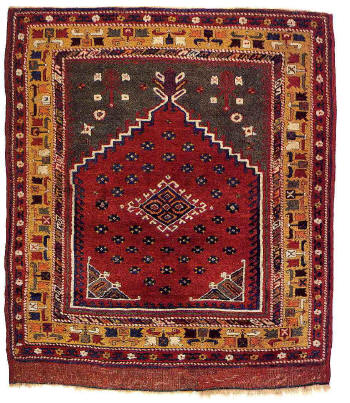| |
 |
|
| |
7
Western Anatolia
Prayer Rug (sejjadeh),
19th century
The wide field of this rug is topped by a
stepped arch very common on Anatolian prayer rugs. These steps
suggest the silhouette of honeycomb vaulting (muqarnas) over
the prayer niches and portals of Seljuk and Ottoman mosques. At the
bottom of the field, the triangular cornerpieces with nested
lozenges and protruding interlaces testify to the long life of rug
motifs; they are portions of the same medallions that appear on
Turkish rugs exported to Europe from western Anatolia as early as
the 15th century. For all its historic allusions, the intense
primary and secondary colors of this rug give it visual immediacy.
In the main border, the weaver has skillfully distributed the
simplified flowering plants - managing to avoid chopping them off at
side or end even though she was working from memory - and has
explored the possible permutations of the bold colors, only rarely
repeating herself. J.B. |
|
| |
|
|
|
|
| |
|
Structural Analysis |
|
SIZE: |
51
X431/2 in. (129.5 x 110.5 cm.) |
|
WARP: |
wool, Z2S;
ivory, light brown |
|
WEFT: |
wool, z x 2;
red |
|
PILE: |
wool, Z2S,
symmetrical knots, h. 9, v. 12, 108
k/sq. in., design woven opposite direction to pile;
ivory, dark brown, red, light orange, gold, blue-green,
blue (abrash), dark purple |
|
ENDS: |
red and blue wool weft-faced plain weave, cut |
|
SIDES: |
red wool
selvedge of 6 cords, mostly replaced |
| |
|
|
|
|
|
THROUGH THE COLLECTOR'S EYE |
 |
|
Oriental Rugs from New England Private Collections |
| |
|
|
|